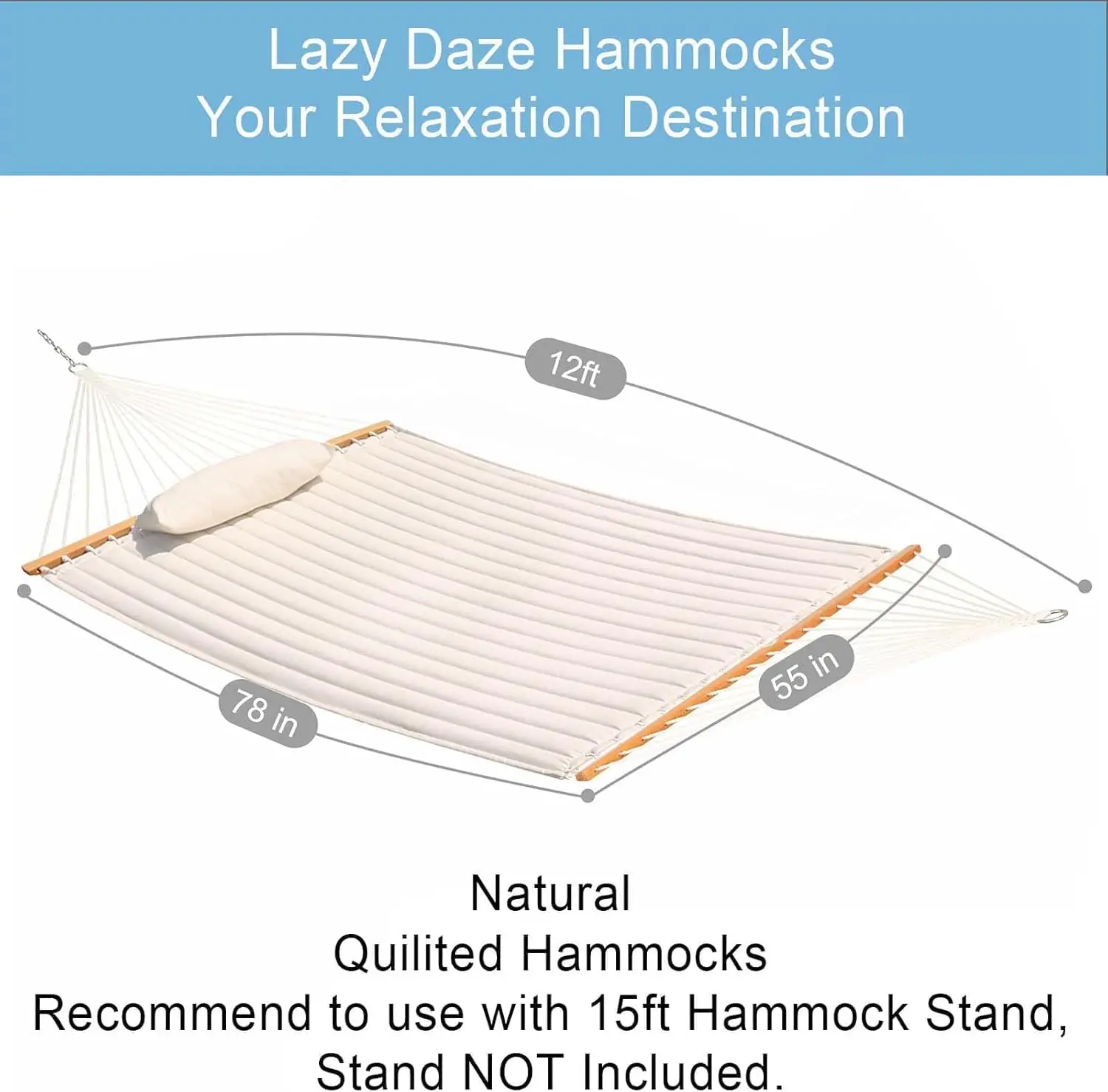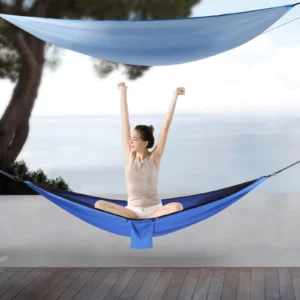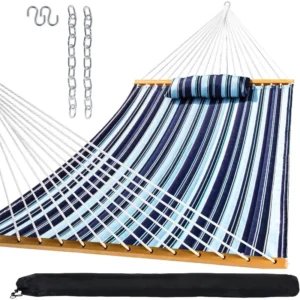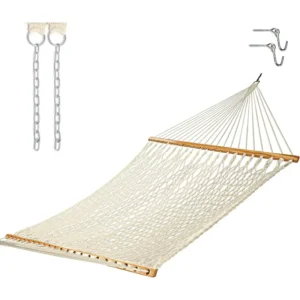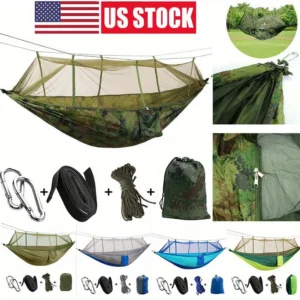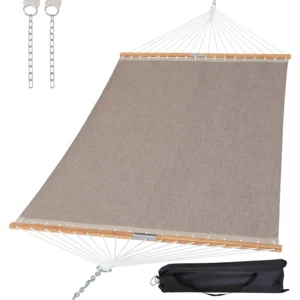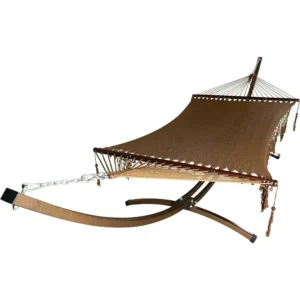What Makes Quilted and Non-Quilted Hammocks Different?
| Feature | Quilted Hammocks | Non-Quilted Hammocks |
|---|---|---|
| Construction | Two fabric layers with padding between | Single layer of material without padding |
| Weight | Heavier (10-15 pounds/4.5-6.8 kg) | Lighter (1-2 pounds/0.45-0.9 kg for ultralight models) |
| Design | Often includes spreader bars | Typically gathered-end design |
| Comfort | Plush, cushioned surface | Body-conforming, cocoon-like feel |
| Insulation | Built-in padding provides warmth | Minimal insulation; may require accessories |
| Portability | Limited; best for semi-permanent setup | Highly portable; easy to pack and transport |
| Durability | Depends on fabric quality but generally sturdy | Varies by material (nylon, cotton, polyester) |
The fundamental difference between quilted and non-quilted hammocks lies in their construction. Quilted hammocks feature two layers of fabric with padding sandwiched between them, creating a plush, mattress-like surface. They typically incorporate spreader bars—wooden or metal rods at each end that keep the hammock surface flat and open.
In contrast, non-quilted hammocks consist of a single layer of fabric or woven material without additional padding. They commonly feature a gathered-end design where the fabric bunches together at the suspension points, creating a natural cocoon effect when occupied. This foundational difference influences every aspect of the hammock experience, from comfort and warmth to portability and price.
Understanding proper indoor and outdoor hammock placement becomes especially important once you’ve decided which hammock type best suits your needs.
Understanding Quilted Hammocks: Premium Comfort for Leisurely Lounging
Quilted hammocks represent the luxury option in the hammock world, designed primarily for comfort and style. These hammocks typically feature two layers of durable outdoor fabric with soft polyester or cotton batting sandwiched between them. Common fabric choices include weather-resistant materials like Sunbrella and DuraCord, specially engineered to withstand outdoor conditions while maintaining a soft feel.
Most quilted hammocks measure between 13 and 15 feet (4-4.6 meters) in total length, providing ample space for one or two people with weight capacities typically ranging from 300 to 450 pounds (136-204 kg). The defining structural element is often the inclusion of spreader bars—hardwood or metal rods at each end that keep the hammock taut and flat.
This construction creates a remarkably different experience from traditional hammocks. Rather than enveloping you in fabric, quilted hammocks provide a more bed-like surface that stays relatively flat. The padding creates a cushioned barrier between your body and the supporting material, eliminating pressure points and preventing the rope or fabric pattern from imprinting on your skin during extended lounging.
As semi-permanent outdoor furniture, quilted hammocks often become a centerpiece in backyard landscapes. Their decorative appeal extends beyond mere functionality, with many options featuring vibrant patterns, elegant color schemes, and coordinated pillows that enhance outdoor living spaces.
Our quilted fabric hammock sets offer various styles to match your outdoor aesthetic while providing premium comfort.
Advantages of Quilted Hammocks
Superior Comfort: The built-in padding creates a cushioned surface that eliminates pressure points and provides mattress-like support for extended relaxation. Many users find they can comfortably lounge for hours without discomfort.
Built-in Insulation: The padding layer naturally traps body heat, making quilted hammocks comfortable in cooler conditions down to approximately 60°F (15.5°C) without requiring additional insulation accessories.
Weather Resistance: Premium quilted hammocks often feature fabrics specifically engineered for outdoor use, with UV protection to prevent fading and water-resistant properties that shed light moisture.
Aesthetic Appeal: With their decorative fabrics, coordinated designs, and substantial presence, quilted hammocks serve as attractive outdoor furniture pieces that enhance patio and garden spaces.
Stability and Accessibility: The spreader bar design creates a flat, stable surface that’s easier to get into and out of compared to traditional gathered-end hammocks, making them more accessible for all ages.
The unmatched comfort of quilted hammocks makes them particularly appealing for dedicated relaxation spaces where the hammock remains set up permanently or seasonally.
Limitations of Quilted Hammocks
Weight and Bulk: At 10-15 pounds (4.5-6.8 kg) or more, quilted hammocks aren’t designed for portability. Their bulky nature makes them challenging to transport and requires significant storage space when not in use.
Moisture Sensitivity: The padded interior can trap moisture, leading to potential mildew issues and significantly longer drying times. While the outer fabric may dry within hours, the internal padding can take 24+ hours to dry completely after rain exposure.
Heat Retention: The insulation that makes quilted hammocks cozy in cool weather becomes a disadvantage in hot conditions, potentially becoming uncomfortably warm during summer heat waves.
Price Point: Quality quilted hammocks typically require a higher investment, with prices starting around $100 and premium options exceeding $300, reflecting their durable materials and more complex construction.
Stability Learning Curve: The spreader bar design, while providing a flat surface, can be prone to tipping for first-time users who haven’t learned proper weight distribution techniques.
Understanding whether it’s okay to leave hammocks outside becomes particularly relevant for quilted options, as their materials and construction require more careful weather consideration.
Exploring Non-Quilted Hammocks: Versatile Simplicity for Every Adventure
Non-quilted hammocks encompass a diverse range of styles united by their simpler construction without internal padding. These include several distinct types:
Camping/Parachute Hammocks: Made from lightweight nylon or polyester similar to parachute material, these hammocks prioritize low weight and high packability. They typically feature a gathered-end design where the fabric bunches at the suspension points, creating a natural cocoon-like wrap when occupied. Weight capacities generally range from 300-500 pounds (136-227 kg), despite their lightweight construction of 1-2 pounds (0.45-0.9 kg).
Rope Hammocks: The classic hammock design featuring woven cotton or synthetic rope in an open lattice pattern. Some incorporate spreader bars for a flatter lying surface, while others use the traditional gathered-end approach. The open weave provides excellent airflow but less surface support.
Brazilian/Mayan Hammocks: Tightly woven from cotton or nylon threads in colorful patterns, these traditional designs lack spreader bars and are designed for diagonal lying. They strike a balance between the lightweight functionality of camping hammocks and the comfort of more substantial options.
The key characteristic of all non-quilted hammocks is their body-conforming nature. Rather than providing a flat surface, they naturally cradle the occupant, distributing weight evenly across the fabric or rope network. This creates a distinctly different comfort experience that many users prefer for both lounging and sleeping.
Our collection of rope hammock sets offers traditional non-quilted options with classic appeal and excellent breathability.
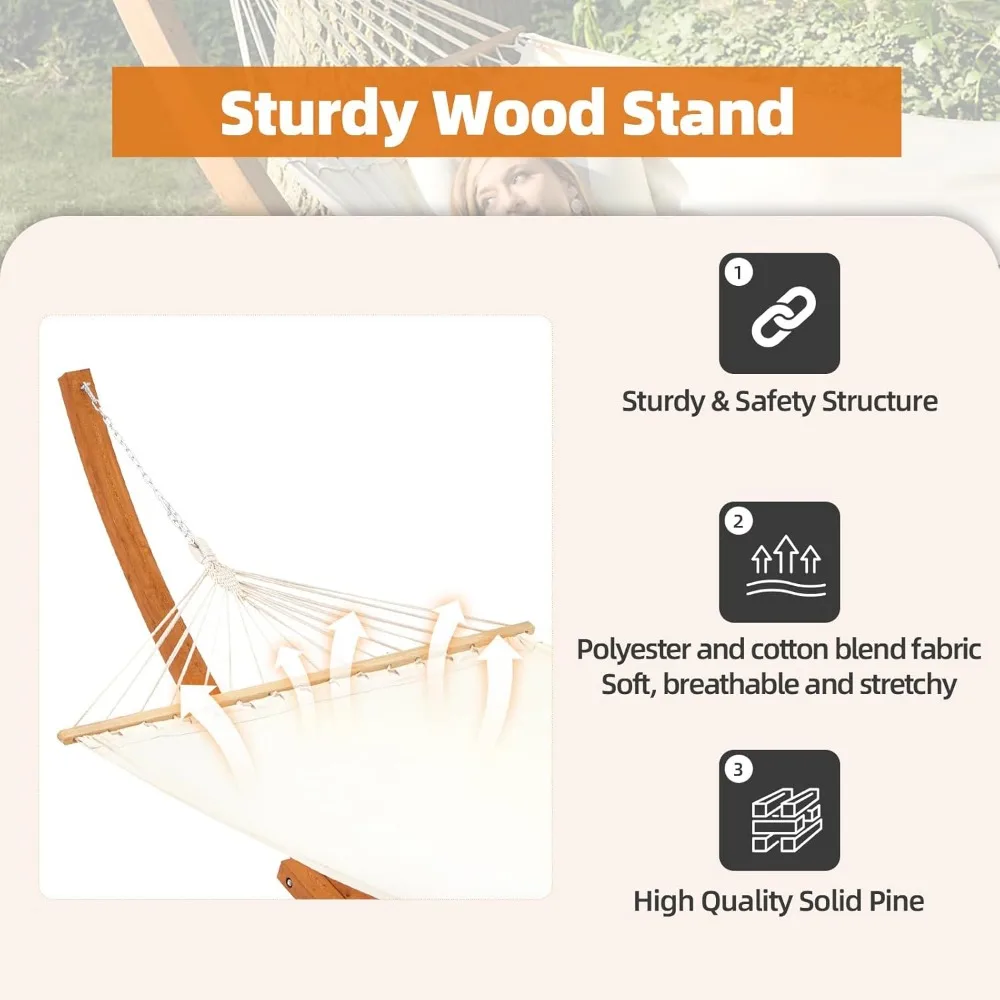
Advantages of Non-Quilted Hammocks
Lightweight Portability: Camping/parachute hammocks typically weigh just 1-2 pounds (0.45-0.9 kg) and pack down to approximately 5×7 inches (12.7×17.8 cm), making them ideal companions for hiking, backpacking, and travel.
Quick-Drying Properties: Without internal padding to trap moisture, non-quilted hammocks dry remarkably quickly—typically 30-60 minutes for nylon versions in sunny conditions—making them resilient in unpredictable weather.
Superior Breathability: The single-layer design allows for maximum airflow, preventing overheating in warm conditions and making them perfect for hot summer days or tropical environments.
Versatile Applications: From ultralight backpacking to beach days to backyard lounging, non-quilted hammocks adapt to various settings and activities with minimal fuss.
Wide Price Range: Options start at budget-friendly price points around $20-30 for basic models, with premium versions still typically costing less than their quilted counterparts.
Easy Maintenance: Most non-quilted hammocks can be machine washed and air-dried quickly, simplifying care and extending their usable life.
For those prioritizing minimal weight and maximum portability, our ultralight camping hammock sets provide exceptional performance in a compact package.
Limitations of Non-Quilted Hammocks
Limited Insulation: The single-layer construction offers minimal temperature protection, making additional insulation necessary in temperatures below 70°F (21°C). Underquilts and top quilts are often required for cool weather use, adding to the overall cost and complexity.
Potential Pressure Points: Particularly in rope hammocks, the weave pattern can create pressure points against the skin during extended use, sometimes leaving temporary impression marks.
Learning Curve for Comfort: Achieving optimal comfort often requires learning to lie diagonally across the hammock to create a flatter surface, a technique that may not be intuitive for beginners.
Less Cushioning: Without padding, non-quilted hammocks provide a firmer resting surface that some users may find less comfortable for extended lounging.
Weather Vulnerability: While quick-drying, these hammocks offer limited protection from environmental elements, often requiring additional accessories (tarps, bug nets) for full weather protection.
Material-Specific Concerns: Cotton versions require more careful maintenance and are susceptible to mold if stored damp, while some inexpensive synthetic options may deteriorate under prolonged UV exposure.
Finding the best indoor and outdoor hammock locations becomes particularly important with non-quilted options, as proper setup significantly impacts comfort and performance.
Head-to-Head Comparison: Making Your Decision Easier
When deciding between quilted and non-quilted hammocks, several key factors should guide your decision:
Comfort Preferences: Consider your sleeping position and comfort priorities. Quilted hammocks provide a flatter, more padded surface similar to a suspended bed, ideal for back and occasional side sleepers who prefer minimal body contour. Non-quilted hammocks create a cocoon-like embrace that naturally aligns your body in a curved position, preferred by those who enjoy feeling gently cradled during rest.
Climate Considerations: Your local weather patterns should heavily influence your choice. Quilted hammocks excel in moderate temperatures and cooler conditions down to about 60°F (15.5°C) without additional gear. Non-quilted options shine in hot weather with superior ventilation but require supplementary insulation (adding $80-200 to the total cost) when temperatures drop below 70°F (21°C).
Portability Requirements: Weight and packability create perhaps the clearest distinction between types. If you’ll be hiking, traveling, or frequently moving your hammock, non-quilted options at 1-2 pounds (0.45-0.9 kg) offer significant advantages over the 10-15 pound (4.5-6.8 kg) quilted alternatives.
Setup Space: Quilted hammocks with spreader bars typically require fixed anchor points 2-3 feet (0.6-0.9 meters) wider than the hammock length, while many non-quilted designs can adapt to closer hanging points, making them more versatile for varying spaces.
Budget Considerations: Initial investment differs significantly, with quality non-quilted hammocks available from $60-150 versus $100-300+ for quilted options. However, additional accessories for non-quilted hammocks (underquilts, tarps) can narrow this price gap for cold-weather use.
Aesthetic Integration: If your hammock will serve as a semi-permanent fixture in a designed outdoor space, the decorative fabrics and substantial presence of quilted options may better complement your landscape design.
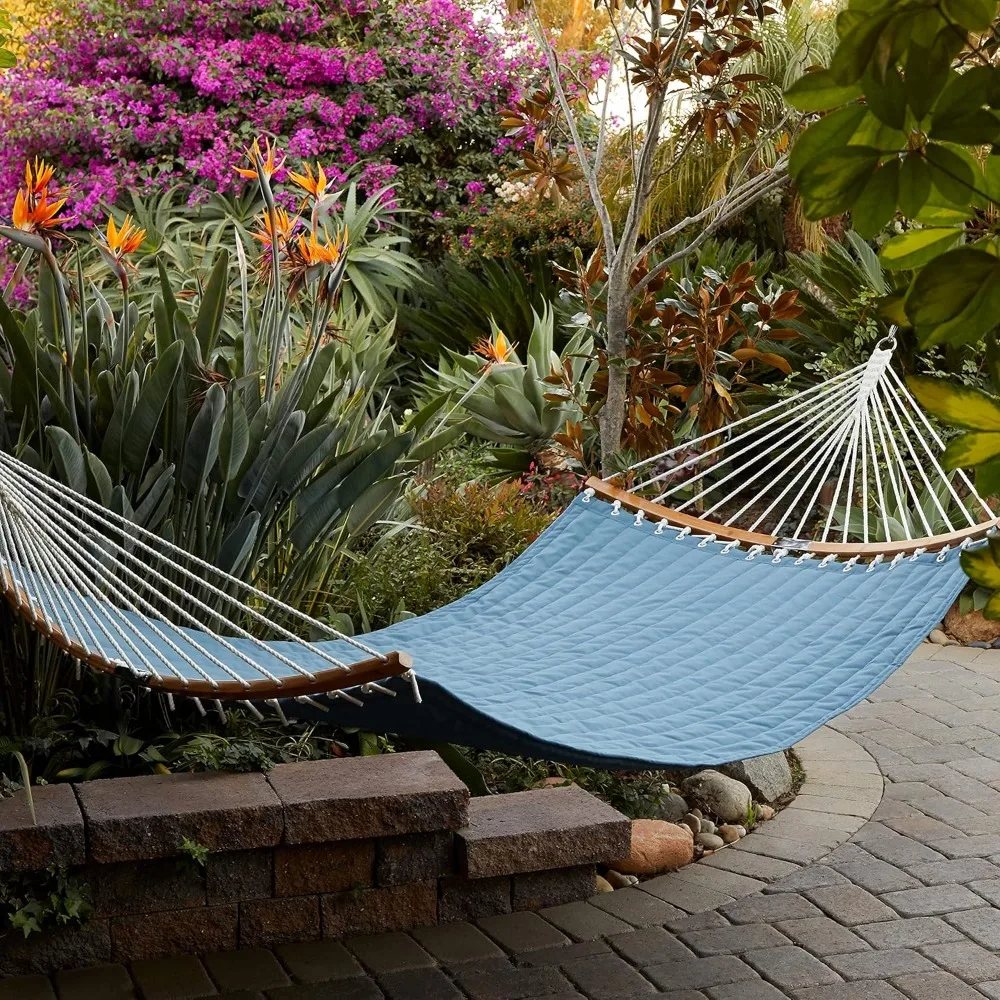
The design differences between spreader bar vs gathered-end hammocks create fundamentally different experiences that appeal to different relaxation styles.
Which Hammock Type Is Best For Your Needs?
For Backyard Relaxation Enthusiasts: If your hammock will primarily serve as an outdoor lounge space for reading, napping, and leisurely afternoons, a quilted hammock with spreader bars offers the most bed-like comfort and easiest entry/exit. The decorative fabrics and substantial presence also enhance your outdoor living space aesthetically.
For Campers and Backpackers: Those prioritizing portability for outdoor adventures should opt for lightweight non-quilted parachute hammocks. Their minimal packed size (similar to a softball) and weight (under 2 pounds/0.9 kg) make them practical additions to any gear collection, and they can double as emergency shelters in suitable environments.
For Hot Climate Users: In consistently warm regions, non-quilted rope or parachute hammocks provide superior ventilation that prevents overheating and sticky discomfort. Their quick-drying properties also make them resilient against afternoon thunderstorms and high humidity.
For Cold Climate Users: In regions with cooler average temperatures, quilted hammocks offer built-in insulation that extends the comfortable usage season without additional accessories. For dedicated cold-weather hammock camping, a non-quilted hammock with a proper underquilt system provides greater versatility.
For Design-Conscious Consumers: If aesthetic integration with your outdoor living space is paramount, quilted hammocks with their decorative fabrics and substantial visual presence generally offer greater design appeal and come in more color and pattern options.
For Budget-Minded Shoppers: Entry-level non-quilted hammocks provide the most affordable introduction to hammock ownership, with functional options starting under $50. However, for occasional casual use without transport needs, basic quilted hammocks may offer better value by including essential comfort features without requiring accessories.
Our spreader bar hammock sets provide a flat, stable surface that many users find ideal for backyard relaxation zones.
Essential Hammock Accessories to Enhance Your Experience
Suspension Systems: Tree-friendly straps with multiple attachment points allow for quick, adjustable setup without damaging trees. Look for systems rated at least 400 pounds (181 kg) above your hammock’s weight capacity for safety.
Hammock Stands: Essential for areas without suitable trees, stands provide reliable support and allow for precise positioning. Portable stands are available for non-quilted hammocks, while sturdier permanent options better suit quilted versions.
Weather Protection: Rain flies and tarps extend your hammock’s usable conditions significantly. Diamond-shaped tarps offer minimal coverage for fair weather, while hexagonal or rectangular tarps provide comprehensive protection in serious storms.
Insulation Systems: For non-quilted hammocks in cooler weather, underquilts hang beneath the hammock to prevent compression of insulation, while top quilts or sleeping bags provide top-side warmth. These typically add 1-3 pounds (0.45-1.36 kg) but expand usage into colder seasons.
Bug Protection: Integrated bug nets or separate systems protect against insects without compromising comfort. Some designs create a completely enclosed sleeping environment, while others focus on overhead protection.
Comfort Enhancers: Specialized pillows, ridgelines for hanging accessories, organization pockets, and structural additions like “bridge” designs can transform basic hammocks into fully-featured relaxation systems.
Our camping hammock sets with bug nets provide comprehensive protection for outdoor adventures while maintaining comfort and convenience.
Camping Hammock Sets with Bug Net, Ultralight Camping Hammock Sets
$139.72 Select options This product has multiple variants. The options may be chosen on the product pageDouble / Two Person Hammock Sets, Rope Hammock Sets
Double Traditional Cotton Rope Hammock with Extension Chains – 450 lbs Capacity for Backyard & Patio$292.98 Select options This product has multiple variants. The options may be chosen on the product pageCamping Hammock Sets with Bug Net, Complete Camping Hammock Systems
Price range: $82.73 through $97.96 Select options This product has multiple variants. The options may be chosen on the product pageDouble / Two Person Hammock Sets, Heavy Duty Hammock Sets, Rope Hammock Sets, Wooden Arc Stand Hammock Sets
Price range: $749.19 through $922.11 Select options This product has multiple variants. The options may be chosen on the product page
Expert Tips for Maximum Hammock Comfort and Longevity
Perfect Your Hang Angle: Suspend your hammock with approximately 30° angle in the suspension straps for optimal stability and comfort. This creates the ideal sag that allows for flat diagonal lying in non-quilted hammocks.
Master Diagonal Positioning: Especially in non-quilted hammocks, lying diagonally across the center line (approximately 30° off-center) creates a flatter, more ergonomic surface that eliminates the “banana” curve and reduces pressure on your back.
Protect From UV Damage: Even UV-resistant fabrics benefit from occasional breaks from direct sunlight. Consider positioning to avoid all-day sun exposure or using a protective cover when not in use for extended periods.
Practice Safe Entry and Exit: Approach the hammock from the side and sit down first before swinging your legs up and in. This “sit-and-spin” technique prevents tipping, particularly in spreader bar designs.
Store Properly When Not In Use: Always ensure your hammock is completely dry before long-term storage to prevent mold and mildew. Quilted hammocks especially benefit from storage in breathable bags rather than plastic containers.
Follow Material-Specific Cleaning: Clean quilted hammocks with mild soap and gentle scrubbing, avoiding pressure washers or harsh chemicals. Most non-quilted synthetic hammocks can be machine washed on gentle cycle and air-dried.
Hang at Proper Height: The ideal height is approximately 18 inches (45.7 cm) from the ground when weighted. This allows easy access while preventing ground contact when fully loaded.
For comprehensive setup information, our hammock installation requirements and safety guide provides detailed instructions for secure mounting.
Frequently Asked Questions About Hammock Types
Can quilted hammocks be used for camping?
While possible for car camping with ample space, quilted hammocks aren’t practical for traditional camping due to their weight, bulk, and sensitivity to moisture. They take much longer to dry if they get wet and require more substantial support structures.
Are non-quilted hammocks comfortable for sleeping?
Yes, when properly set up with diagonal lying position. Many hammock campers report better sleep quality compared to ground sleeping. For overnight use in cooler weather, additional insulation like an underquilt is essential.
Which type is more durable in outdoor conditions?
With proper care, both types can last many years. Quilted hammocks with quality weather-resistant fabrics typically withstand constant outdoor exposure better but are more vulnerable to mildew if moisture penetrates the padding. Non-quilted synthetic hammocks offer excellent UV and moisture resistance but may have lower abrasion resistance.
How do I choose the right size hammock?
For comfortable use, select a hammock at least 2 feet (0.6 meters) longer than your height. For two-person use, look for hammocks with at least 6 feet (1.8 meters) of fabric width and weight capacities exceeding 400 pounds (181 kg).
Which hammock type is safer for children?
Non-quilted hammocks without spreader bars are generally considered safer for children as they’re closer to the ground and create a natural cocoon that’s difficult to fall out of. Always supervise children using any hammock type.
Are spreader bars better for comfort?
This depends entirely on personal preference. Spreader bars create a flatter, more bed-like surface preferred by some users, but they also make the hammock less stable and more prone to tipping. Many experienced hammock users prefer non-spreader designs for their natural body-conforming properties.
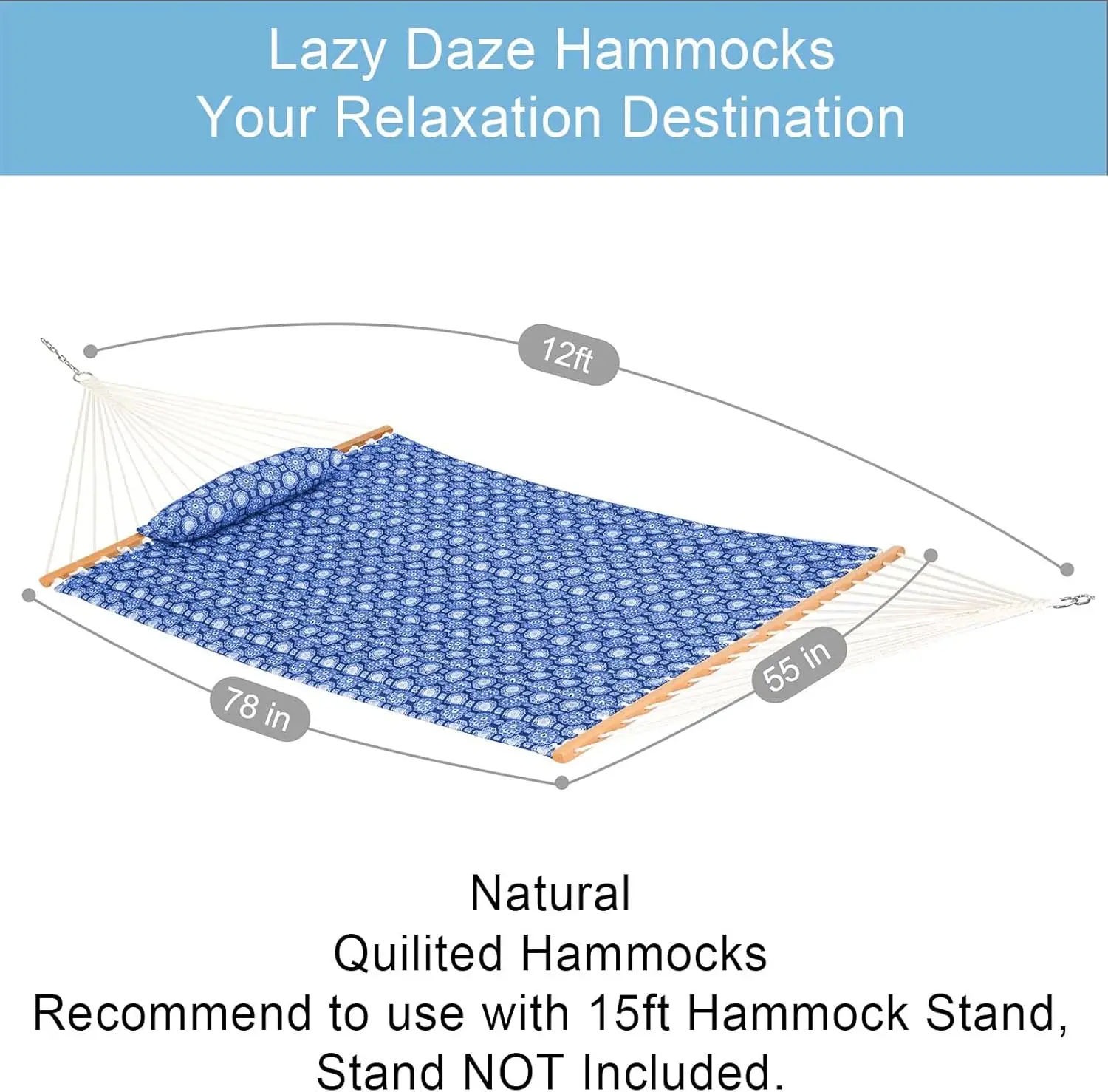
Is a Quilted or Non-Quilted Hammock Better for Specific Weather Conditions?
Rainy Conditions: Non-quilted hammocks have a clear advantage in wet weather, drying in 30-60 minutes of sun exposure compared to 24+ hours for quilted versions. The padding in quilted hammocks absorbs moisture and can develop mildew if not thoroughly dried. However, both types require additional rain protection (tarp) for use during rainfall.
Hot Weather: Non-quilted hammocks, especially those with open weave patterns like rope hammocks, provide superior airflow that prevents overheating and sweat accumulation in temperatures above 80°F (27°C). The padding in quilted hammocks acts as insulation that traps body heat, potentially becoming uncomfortable in high temperatures.
Cold Weather: Quilted hammocks provide built-in insulation effective down to approximately 60°F (15.5°C) without additional accessories. Below this temperature, non-quilted hammocks with dedicated underquilt systems (typically R-value 2.0-4.0) actually outperform quilted options but require the additional investment.
Windy Conditions: The lower profile of non-quilted gathered-end hammocks makes them more wind-resistant and less prone to swaying. Quilted hammocks with spreader bars catch more wind and may create a “sail effect” in breezy locations.
Year-Round Versatility: For environments with significant seasonal variation, non-quilted hammocks with appropriate accessories offer greater adaptability across temperature ranges, while quilted options excel in locations with moderate year-round temperatures.
Our comprehensive indoor vs outdoor hammocks buyer’s guide provides additional insights into selecting the right hammock for your specific environmental conditions.
Outside Luxe’s Approach to Quality Hammocks
At Outside Luxe, we believe the perfect hammock balances comfort, durability, and functionality regardless of design type. Our rigorous selection process includes hands-on testing where team members evaluate comfort during extended use, ease of setup, and stability under various conditions.
We prioritize premium materials in both our quilted and non-quilted collections, selecting fabrics and components that withstand environmental challenges while maintaining comfort. For quilted hammocks, we choose weather-resistant fabrics with UV protection and quick-draining padding materials. For non-quilted options, we select high-tenacity nylons and polyesters with appropriate thread counts for durability without excess weight.
Our design philosophy emphasizes the integration of hammocks into outdoor living spaces, recognizing that these products often become centerpieces of relaxation areas. We carefully balance visual appeal with practical functionality, ensuring our hammocks enhance both your relaxation experience and your outdoor aesthetics.
By offering comprehensive collections of both hammock types with compatible accessories, we enable customers to create personalized relaxation systems suited to their specific environments and comfort preferences.

